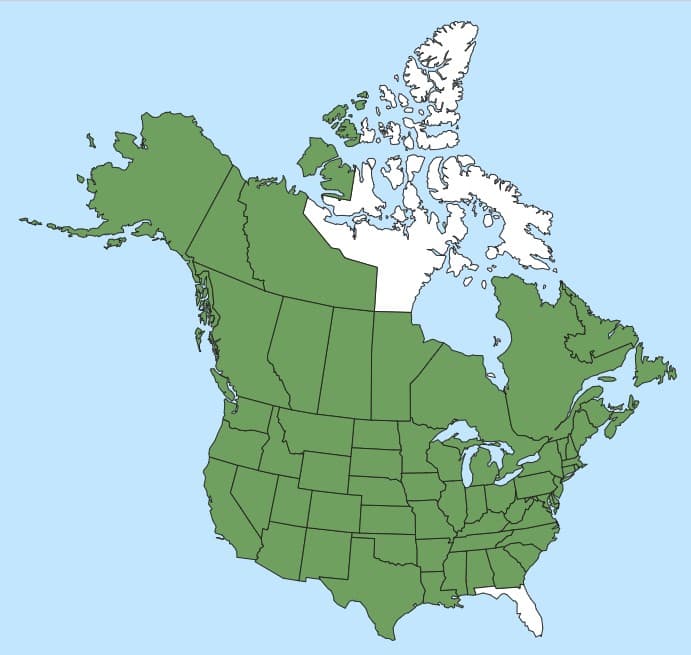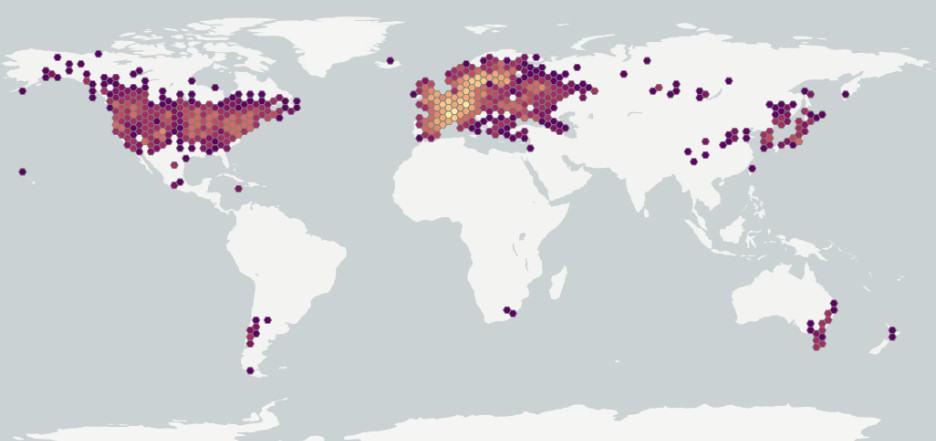Poa compressa
Explore More :
Explore plus :
Overview
Aperçu
Regulation :
Remarques Réglementation:
Regulation Notes:
Distribution :
Répartition :
Poa compressa is native to Europe, northern Africa, and temperate Asia. It has been introduced widely, either as a seed lot contaminant or purposefully cultivated, and in some cases has become naturalized. Outside its native range, Poa compressa is reported to occur in Australia, New Zealand, Argentina, Chile, China, and across much of North America (Wiersema and León 1999; CABI 2023; USDA-ARS 2023).
Habitat and Crop Association :
Habitat et Cultures Associées :
Poa compressa can be found on sunny slopes, in open meadows and forests, in rocky areas, waste ground, roadsides, and other dry places, and on old walls (Bojňanský and Fargašová 2007; St. John et al. 2012; CABI 2023). It grows best on poorly drained or low fertility soils (CABI 2023).
Economic Use, cultivation area, and Weed Association :
Utilisation économique, zone de culture et association de mauvaises herbes :
Poa compressa is used for erosion control on disturbed areas such as roadsides, recreational areas, and mine reclamation sites (St. John et al. 2012), and some commercially available varieties are used for low maintenance turf (Sharp and Alderson 1995; St. John et al. 2012).
Poa compressa is found as a seed lot contaminant, particularly in seed lots of Poa pratensis and grass seed mixtures (Brown and Hillman 1905; Wright 1940; Wiersema and León 1999; CABI 2023).
Duration of Life Cycle :
Durée du cycle vital:
Perennial
Dispersal Unit Type :
Type d’unité de dispersion :
Floret
General Information
RENSEIGNEMENTS GÉNÉRAUX
Introduction and in some cases naturalization outside of its native range has occurred by planting of commercial seed lots of Poa compressa for erosion control and mining reclamation or through contamination of commercial seed lots by Poa compressa (St John et al. 2012; CABI 2023; USDA-ARS 2023). Once established, P. compressa spreads primarily by rhizomes (St. John et al. 2012). Although this species is not classified as a noxious weed seed (GC 2016; USDA-AMS 2023b), in some areas of the United States and Canada, P. compressa is considered an invasive weed (CABI 2023).
In the commercial seed markets, Poa compressa is sometimes purposefully mixed with P. pratensis (Kentucky bluegrass) or P. trivialis (rough bluegrass).
.
Identification
Identification
-
Spikelet
Size
- Spikelet length: (2.3) 3.5 – 7 (8) mm (Douglas et al. 2001; Sharp and Simon 2002; Barkworth et al. 2007).
Spikelet size from literature:
• Spikelet length: 3 – 6 mm; 3 – 6 florets (Edgar and Connor 2000).
• Spikelet length: 3.5 – 7 mm; 3 – 7 florets (Douglas et al. 2001).
• Spikelet length: 3 – 8 mm; 3 – 10 florets (Sharp and Simon 2002).
• Spikelet length: (2.3) 3.5 – 7 mm; 3 – 7 florets (Barkworth et al. 2007).
• Spikelet length: 3.5 – 5 mm; 2 – 4 florets (eFloras 2023).Shape
- Spikelet shape oblong-oval to egg-shaped, laterally compressed.
Surface Texture
- Spikelet surface texture papery with short stiff hairs.
Colour
- Spikelet colour light yellowish brown; may be green or purple tinged.
Other Features
Spikelet composition
- Multiple floret spikelet with 3 – 10 similar looking florets, with florets near spikelet tip usually sterile and slightly smaller in size (Sharp and Simon 2002).
Glumes
- Glumes nearly equal in length; 1.6 – 3 mm long (Sharp and Simon 2002).
- Glumes thin and papery.
- Both glumes egg-shaped, keeled, and 3-nerved.
- Glume keels with short stiff hairs (eFloras 2023).
Disarticulation
- Spikelet disarticulation generally occurs above glumes and between florets at rachilla nodes, although intact spikelets can be occasionally found in commercial seed lots.
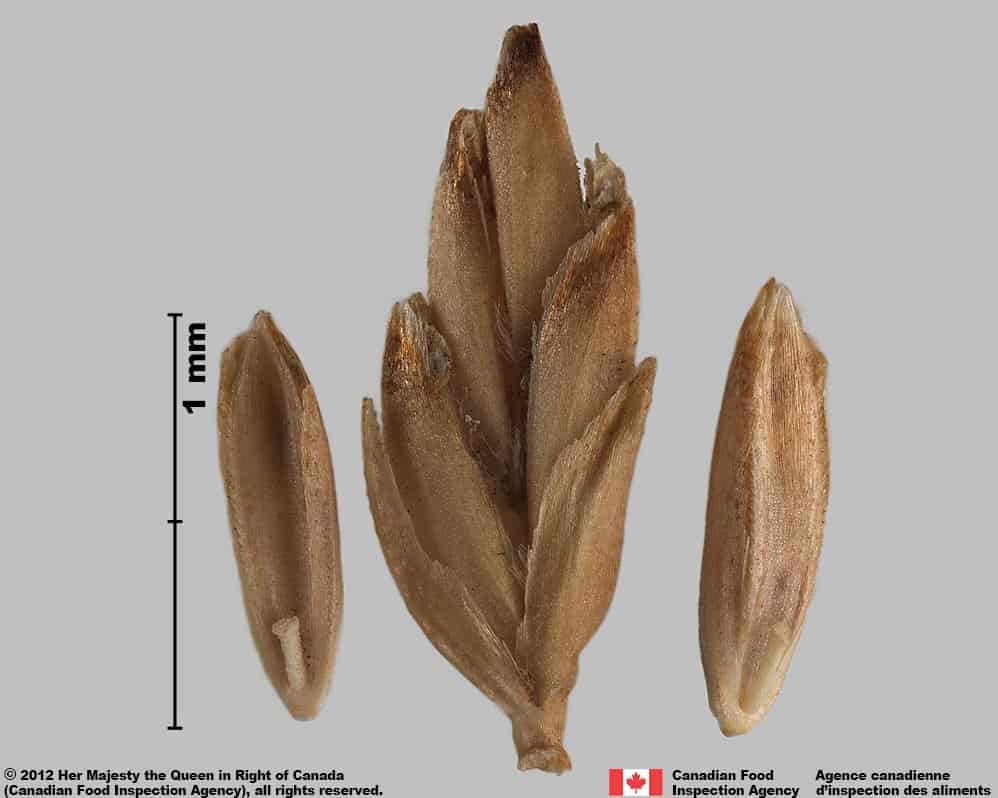
Canada bluegrass (Poa compressa) spikelet and florets

-
Floret
Size
- Floret length*: 1.9 – 3.4 mm (average 2.4 mm); width*: 0.5 – 0.8 mm (average 0.6 mm); thickness*: 0.4 – 0.7 mm (average 0.6 mm).
- Rachilla length*: 0.2 – 1.6 mm (average 0.7 mm).
*Measurement notes: minimum and maximum size based 30 florets in normal range of this species using image measurement protocol (ISMA 2020). Length equals longest measurement of floret, width equals greatest measurement of floret in palea view, thickness equals greatest measurement of floret in lateral view. CDA-S-54694, CDA-S-24866, CDA-S-24845.
Size measurements from literature:
• Lemma length: 2.2 – 2.7 mm; rachilla about 0.4 mm long (Edgar and Connor 2000).
• Lemma length: 2.3 – 3.5 mm; rachilla mostly less than 1 mm long (Douglas et al. 2001).
• Floret length: 2 – 2.4 mm; width: 0.5 – 0.7 mm (Bojňanský and Fargašová 2007).
• Lemma length: 2.3 – 3.5 mm (Barkworth et al. 2007).
• Lemma length: 2.3 – 3.5 mm (eFloras 2023).Shape
- Floret oblong-oval shaped (oblong-lanceolate), slightly compressed laterally, keeled along back of lemma, keel rounded.
- Lemma and palea usually flared open at tip.
Surface Texture
- Lemma and palea papery.
Colour
- Floret light brownish-yellow coloured.
Other Features
Lemma
- Lower two-thirds of keel and marginal nerves with long soft hairs.
- Lateral nerves obscure or lacking.
- Area between nerves without hairs, smooth or granular
- Lemma tip usually flared open.
- Lemma loosely enclosing caryopsis.
- Note: in commercial seed lots, the hairs and some lemma tissue may be removed during the milling processing.
Awn
- Lemma without awn.
Callus
- Callus blunt, with short, silky, web-like hairs (may be missing in milled seed).
Rachilla
- Rachilla about one-eighth to two-thirds the length of the floret (shorter in basal florets and longer in distal florets); smooth and without hairs or covered with tiny, pointed bumps.
Palea
- Palea nearly equal to length of lemma.
- Palea keels two.
- Hairs on palea keels (palea teeth) short, fine, closely spaced, and extending to tip of palea.
- Palea tip slightly notched.
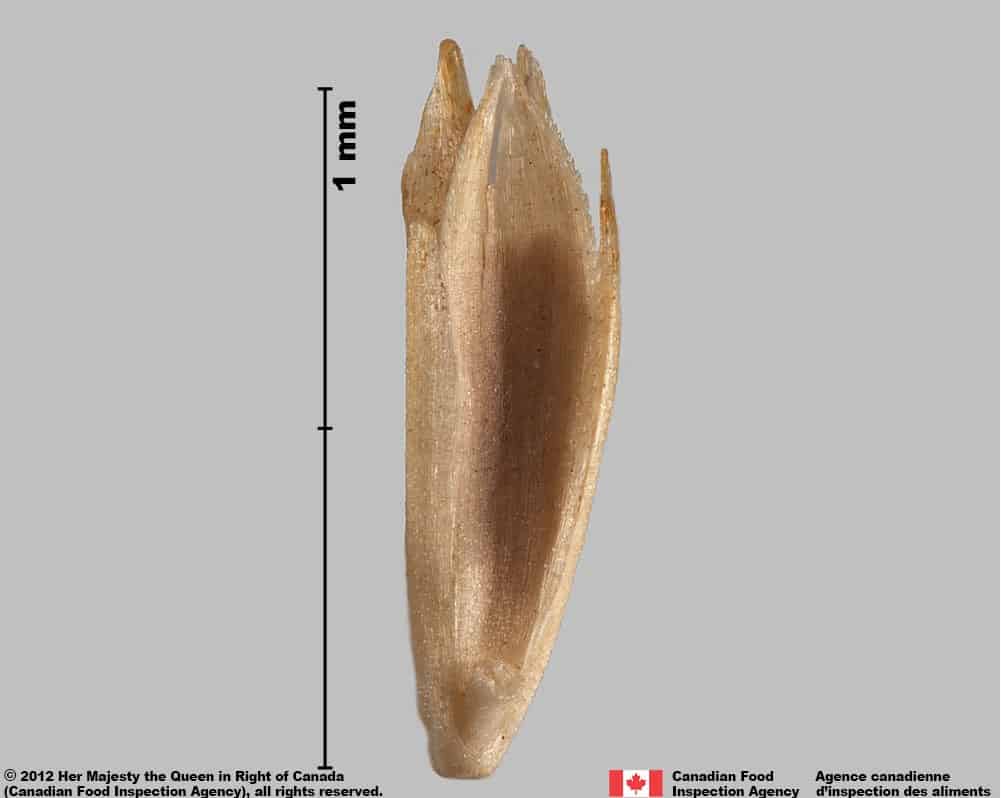
Canada bluegrass (Poa compressa) floret, palea view

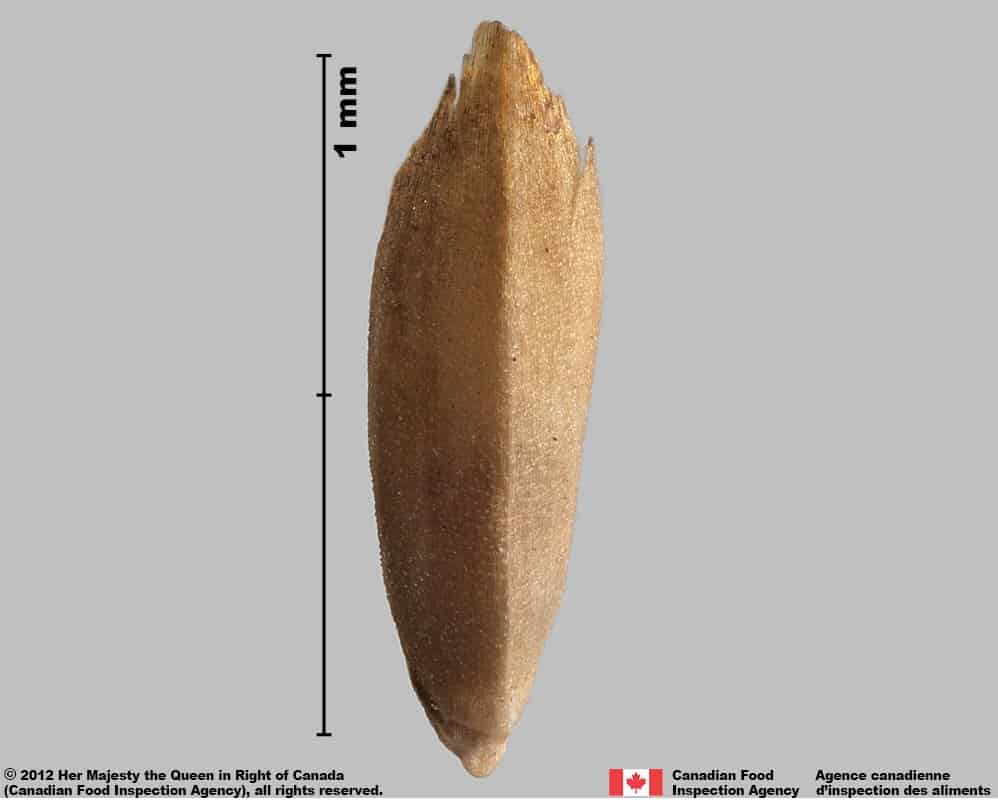
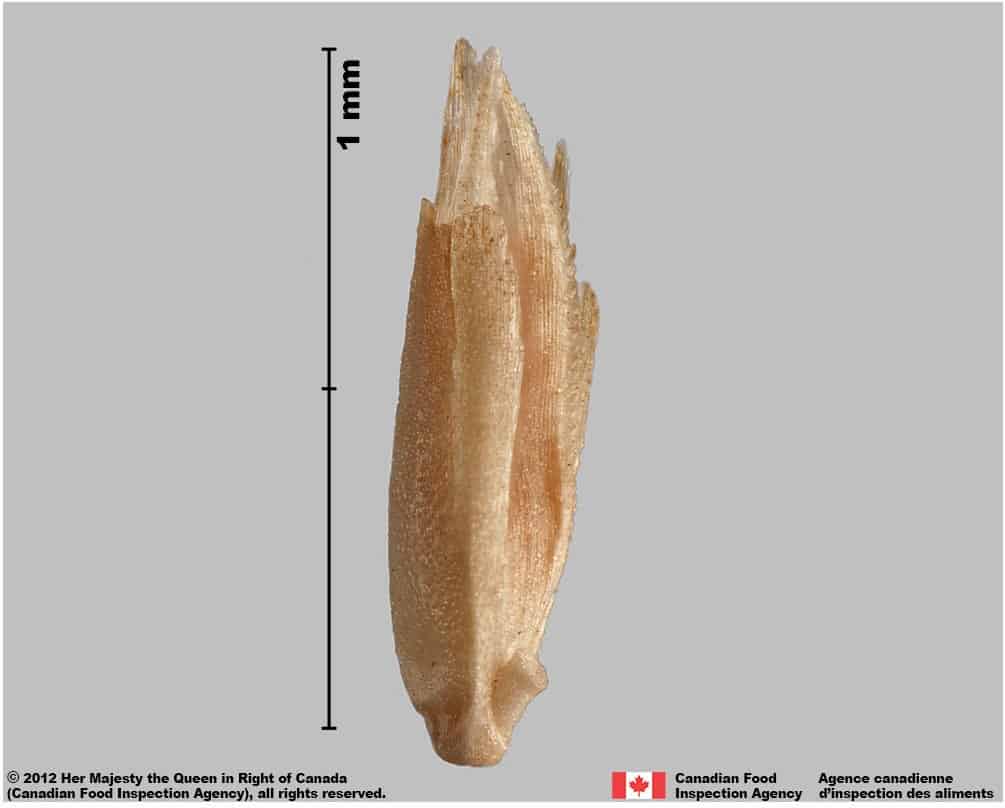
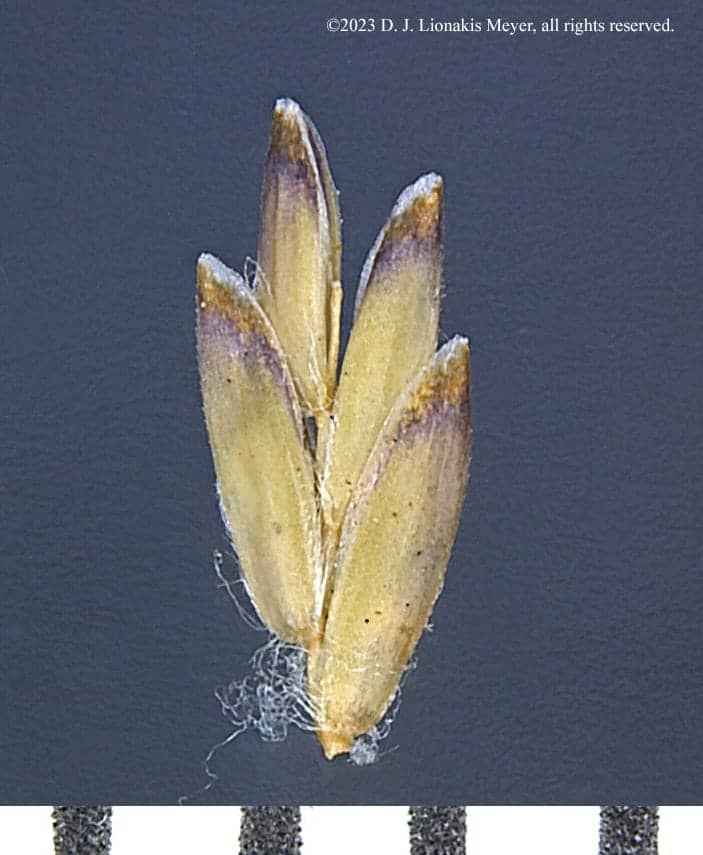
-
Caryopsis
Size
- Caryopsis length*: 1.1 – 1.4 mm (average 1.3 mm); width*: 0.3 – 0.5 mm (average 0.4 mm); thickness*: 0.4 – 0.5 mm (average 0.4 mm).
- Hilum length*: 0.06 – 0.13 mm (average 0.09 mm).
*Measurement notes: minimum and maximum size based 10 caryopses in normal range of this species using image measurement protocol (ISMA 2020). Length equals longest measurement of caryopsis, width equals greatest measurement of caryopsis in embryo view, thickness equals greatest measurement of caryopsis in lateral view. CDA-S-54694.
Caryopsis measurements from literature:
• Caryopsis length: 1.2 – 1.4 mm; width: 0.4 – 0.5 mm (Bojňanský and Fargašová 2007).Shape
- Caryopsis spindle-shaped, slightly compressed laterally, round to triangular in cross-section.
Surface Texture
- Caryopsis surface nearly smooth, slightly shiny.
Colour
- Caryopsis reddish-brown coloured.
Other Features
- Hilum a small round spot located near base of caryopsis on the side opposite the embryo.
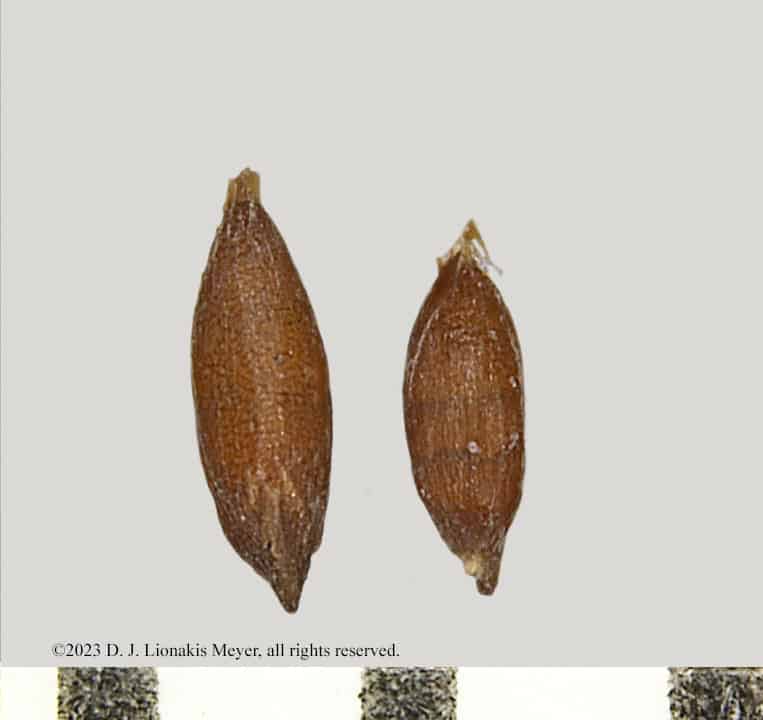
Poa compressa caryopses, embryo view (left) and hilum view (right). Image by Deborah Meyer.

-
Embryo
Size
- Embryo length*: 0.3 – 0.5 mm (average 0.4 mm).
- Embryo about one-quarter to one-third the length of caryopsis.
*Measurement notes: minimum and maximum size based 10 embryos in normal range of this species using image measurement protocol (ISMA 2020). CDA-S-54694.
Shape
- Embryo teardrop shaped.
Endosperm
- Endosperm solid (Terrell 1971).
Other Features
- Embryo lateral (Martin 1946).

Poa compressa caryopses, embryo view (left) and hilum view (right). Image by Deborah Meyer.

Identification Tips
CONSEILS POUR L’IDENTIFICATION
Several characters are key to separating Poa compressa from other species of Poa. These include:
- Lemma and palea usually flared open at tip.
- Marginal and lateral lemma nerves usually not visible.
- Long, soft hairs on lower two-thirds of lemma keel and marginal nerves (may be missing in milled samples).
- Hairs along the palea keels (palea teeth) short, fine, closely spaced, and extending to palea tip.
- Caryopsis loosely enclosed by the lemma.
- Cobweb-like short hairs on the callus (may be missing in milled samples).

Canada bluegrass (Poa compressa) floret, lemma view





Additional Botany Information
AUTRES RENSEIGNEMENTS BOTANIQUES
Flowers/Inflorescence
- Panicle 2 – 11 cm long and 0.5 – 3 cm wide; narrow, oblong to narrowly egg-shaped, contracted to slightly open; containing 15 – 80 spikelets; 1 – 3 branches per node (Sharp and Simon 2002; Barkworth et al. 2007; CABI 2023; eFloras 2023).
Vegetative Features
- Plants usually solitary, sometimes loosely tufted, and with extensive rhizomes (Barkworth et al. 2007; CABI 2023).
- Stems 15 – 60 cm tall, wiry, and strongly compressed (Barkworth et al. 2007; CABI 2023)
Similar Species
ESPÈCES SEMBLABLES
Similar species are based on a study of seed morphology of various species, and those with similar dispersal units are identified. The study is limited by physical specimen and literature availability at the time of examination, and possibly impacted by the subjectivity of the authors based on their knowledge and experience. Providing similar species information for seed identification is to make users aware of similarities that could possibly result in misidentification.
Poa annua, P. pratensis, and P. trivialis can be found as contaminants in seed lots of P. compressa or other types of lawn, turf, and pasture grass seed lots. Key diagnostic features to separate florets these four species are included in the comparison table:
Comparison table of morphological characters of unmilled Poa florets.
| P. compressa | P. pratensis | P. trivialis | P. annua | |
| Floret shape | Lemma and palea usually flared open at tip. | Lemma keeled, keel straight to slightly curved.
Lemma tip folded inward. |
Lemma sharply keeled; keel curved.
Lemma tip folded inward. |
In lateral view the palea appears like a bulging belly.
Lemma tip folded inward or flared out. |
| Lemma | Papery | Papery | Papery, appearing oil soaked. | Papery with membranous margins. |
| Lemma nerves and keel | Lateral nerves obscure or lacking.
Lower two-thirds of keel and marginal nerves with long soft hairs.
|
Lateral nerves prominent, usually without hairs.
Lower two-thirds of keel and marginal nerves with long soft hairs.
|
Marginal and lateral nerves and keel prominent, without hairs. | Lateral nerves prominent. Keel, marginal and lateral nerves with long silky hairs in the lower half. |
| Palea keel hairs (palea teeth) | Short, fine, close-spaced, and extending to tip of palea | Short, coarse, wide-spaced, and not extending to tip of palea | Short, fine, close-spaced, and extending to tip of palea | Long, densely spaced, and not extending to tip of palea |
| Caryopsis | Caryopsis spindle shaped, loosely enclosed by lemma and palea. | Caryopsis spindle shaped, loosely enclosed by lemma and palea. | Caryopsis spindle shaped, tightly enclosed by lemma and palea. | Embryo pinched and beak-like.
Surface with fine-net-like texture. Caryopsis loosely enclosed by lemma and palea. |
| Callus hairs | Short & web-like | Long & web-like | Long & web-like | None |
Click to select species
Cliquez pour sélectionner les espèces
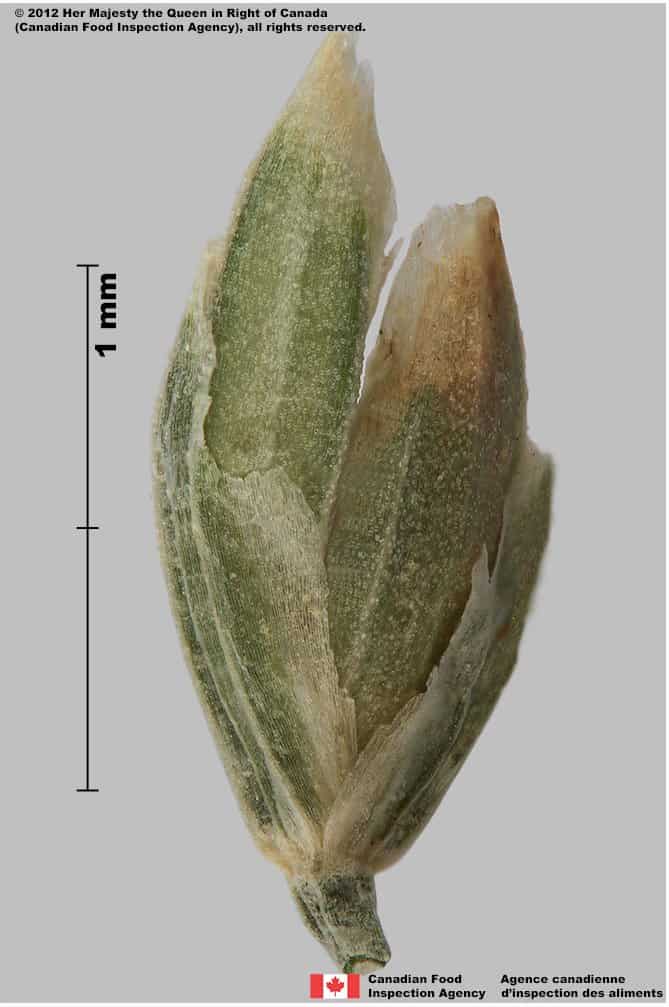
Poa pratensis
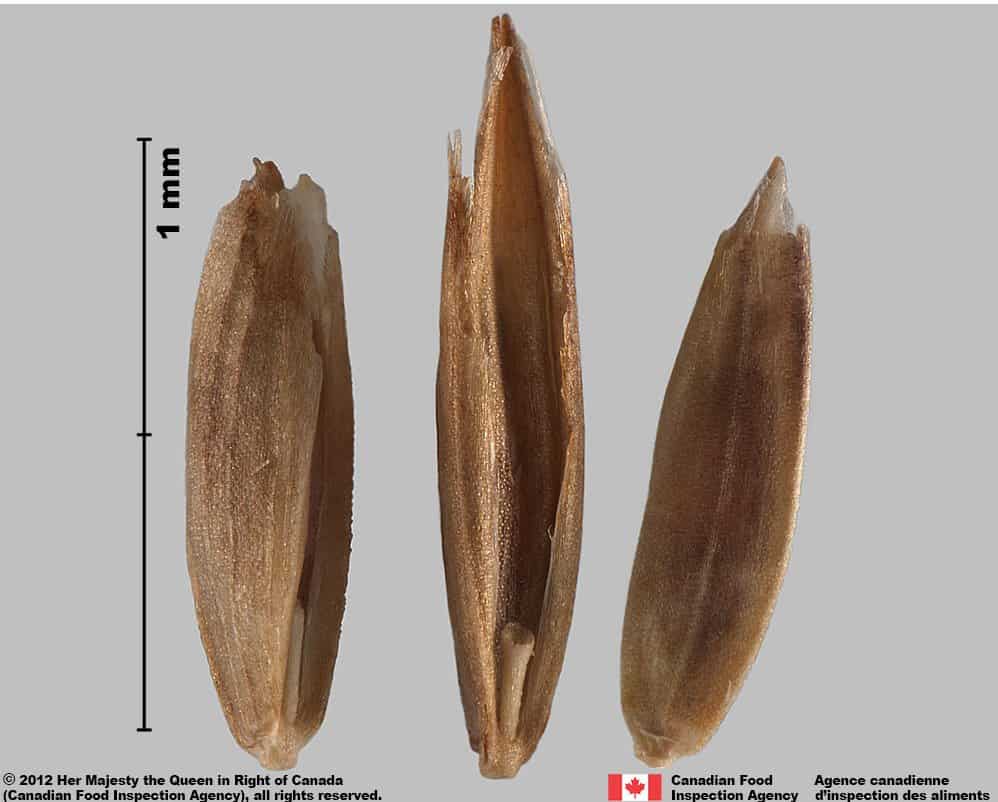
Poa trivialis
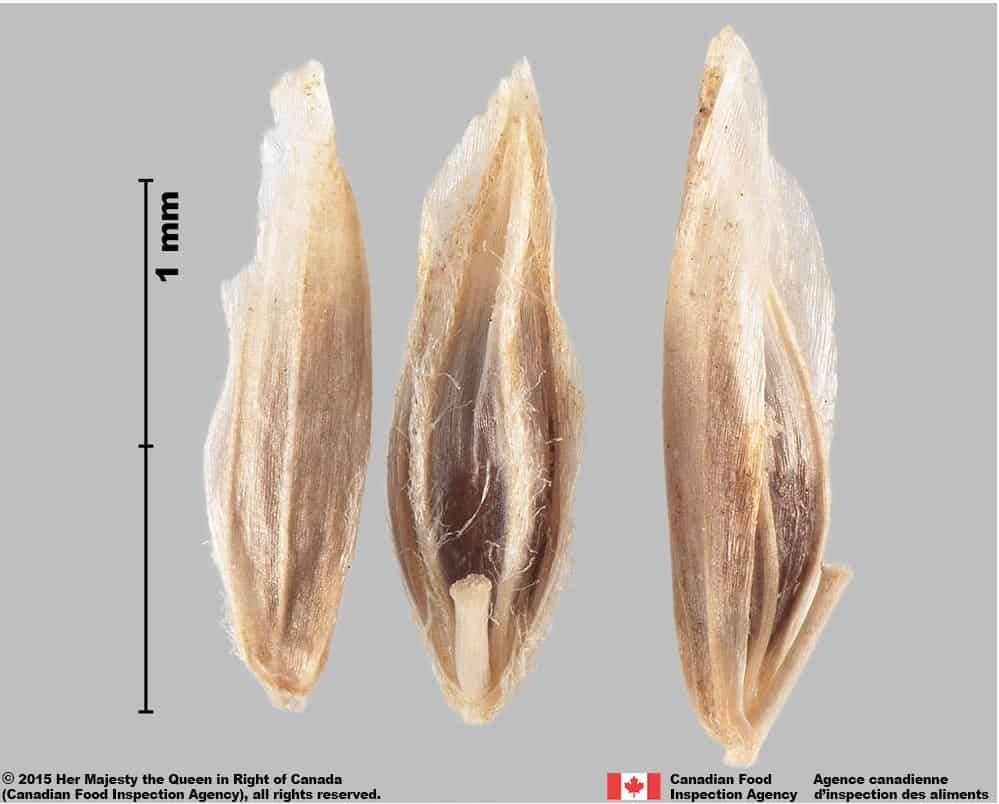
Poa annua
Comparison Window
Fenêtre de comparaison
MAIN SPECIES
ESPÈCES PRINCIPALES
Poa compressa

Poa compressa
Poaceae
Canada bluegrass (Poa compressa) spikelet and florets
MAIN SPECIES
ESPÈCES PRINCIPALES
Poa compressa

Poa compressa
Poaceae
Poa compressa florets showing hairs on callus, silky hairs along lower lemma keel and lower marginal vein, and short stiff hairs along upper lemma keel.
MAIN SPECIES
ESPÈCES PRINCIPALES
Poa compressa

Poa compressa
Poaceae
Canada bluegrass (Poa compressa) floret, palea view
MAIN SPECIES
ESPÈCES PRINCIPALES
Poa compressa

Poa compressa
Poaceae
Canada bluegrass (Poa compressa) floret, side view
MAIN SPECIES
ESPÈCES PRINCIPALES
Poa compressa

Poa compressa
Poaceae
Canada bluegrass (Poa compressa) floret, lemma view
MAIN SPECIES
ESPÈCES PRINCIPALES
Poa compressa

Poa compressa
Poaceae
Poa compressa caryopses, embryo view (left) and hilum view (right). Image by Deborah Meyer.
SIMILAR SPECIES
ESPÈCES SEMBLABLES
Poa pratensis

Poa pratensis
Poaceae
Kentucky bluegrass (Poa pratensis) spikelet
SIMILAR SPECIES
ESPÈCES SEMBLABLES
Poa pratensis
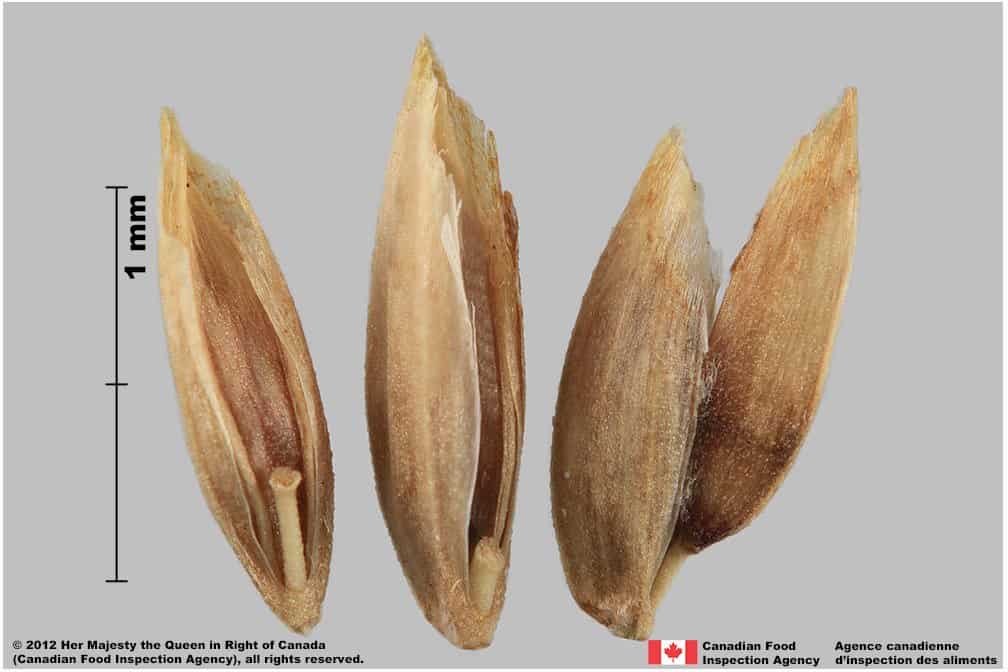
Poa pratensis
Poaceae
Kentucky bluegrass (Poa pratensis) florets
SIMILAR SPECIES
ESPÈCES SEMBLABLES
Poa pratensis
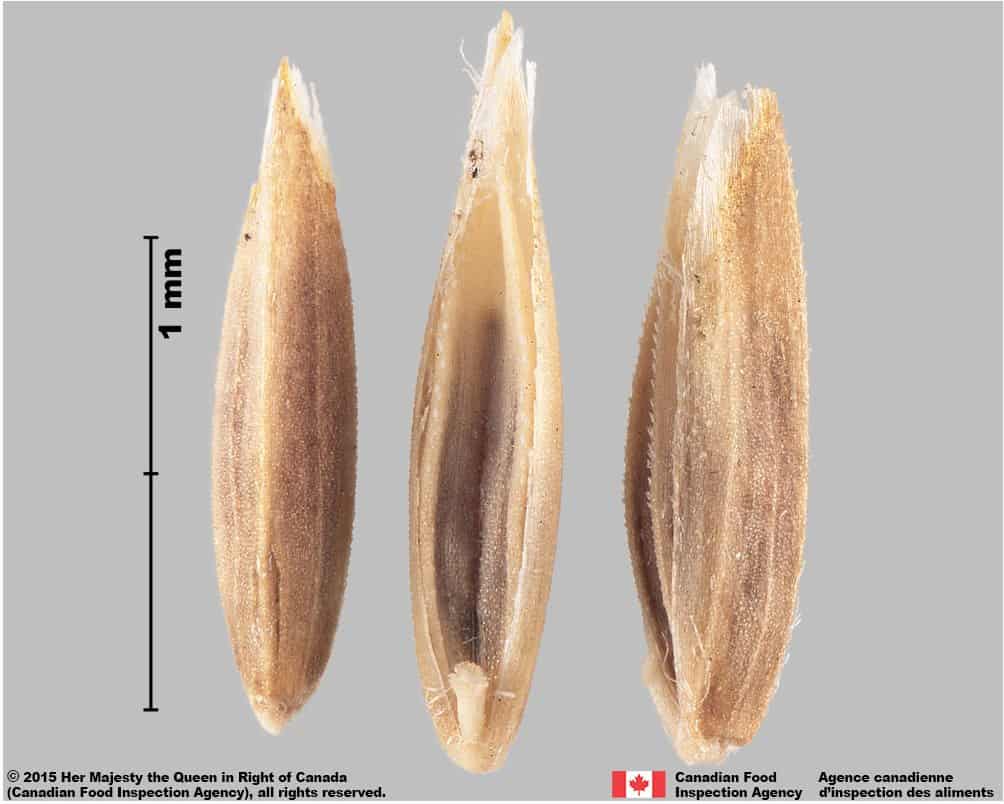
Poa pratensis
Poaceae
Kentucky bluegrass (Poa pratensis) florets
SIMILAR SPECIES
ESPÈCES SEMBLABLES
Poa pratensis
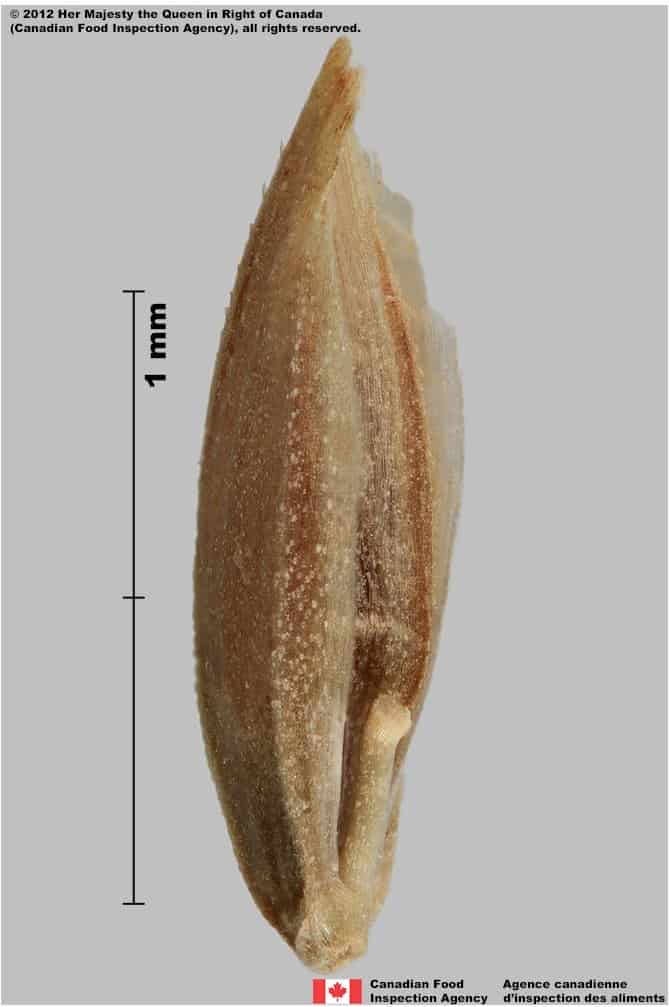
Poa pratensis
Poaceae
Kentucky bluegrass (Poa pratensis) floret, palea view
SIMILAR SPECIES
ESPÈCES SEMBLABLES
Poa pratensis
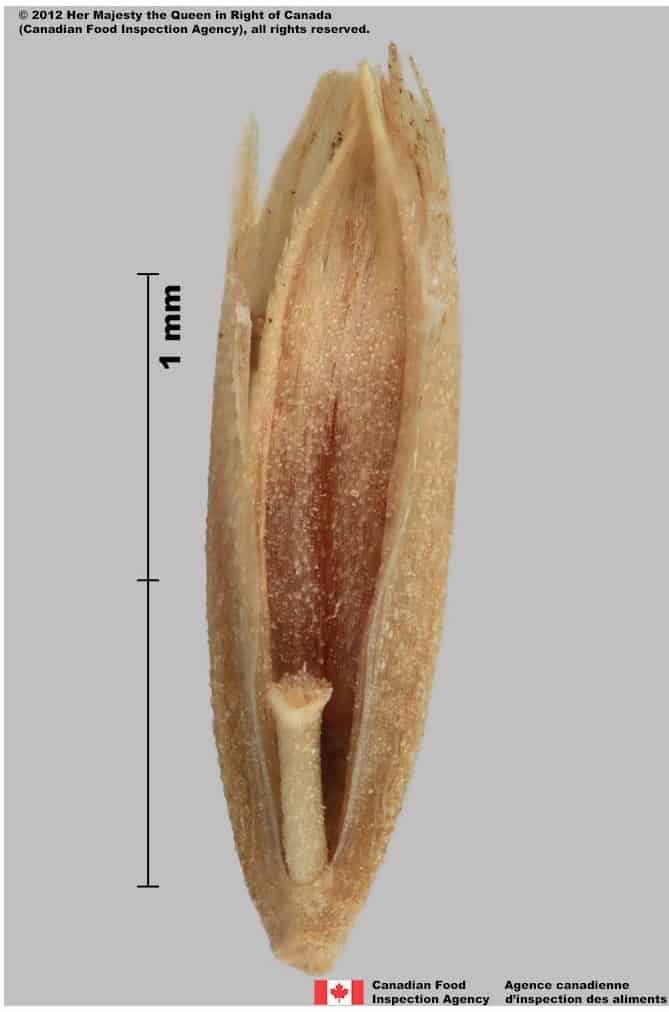
Poa pratensis
Poaceae
Kentucky bluegrass (Poa pratensis) floret, palea view
SIMILAR SPECIES
ESPÈCES SEMBLABLES
Poa pratensis
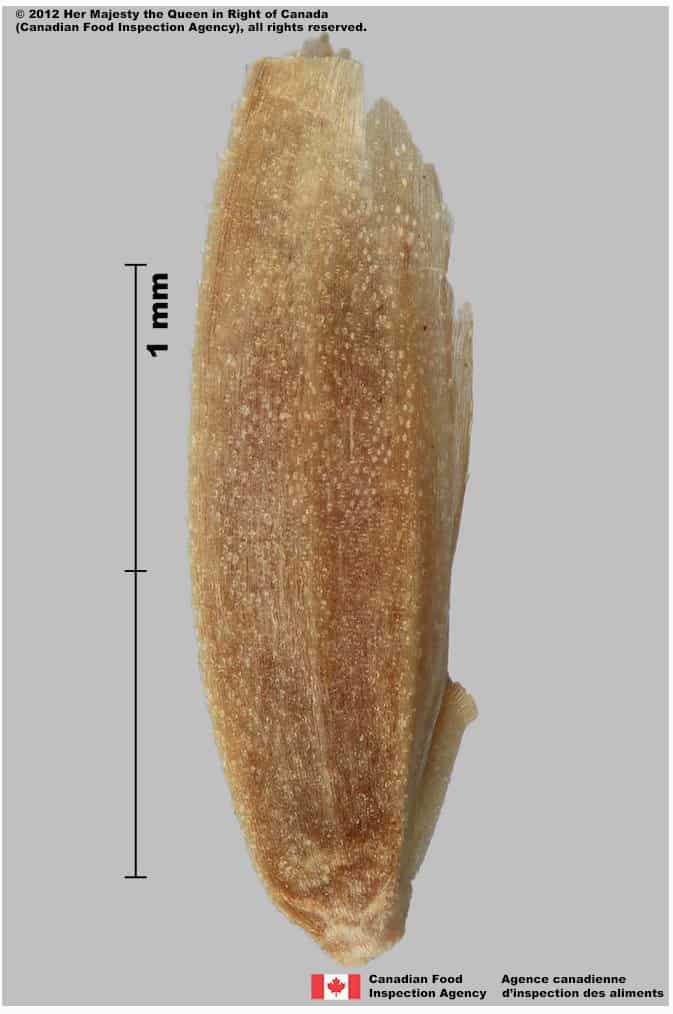
Poa pratensis
Poaceae
Kentucky bluegrass (Poa pratensis) floret, side view
SIMILAR SPECIES
ESPÈCES SEMBLABLES
Poa pratensis
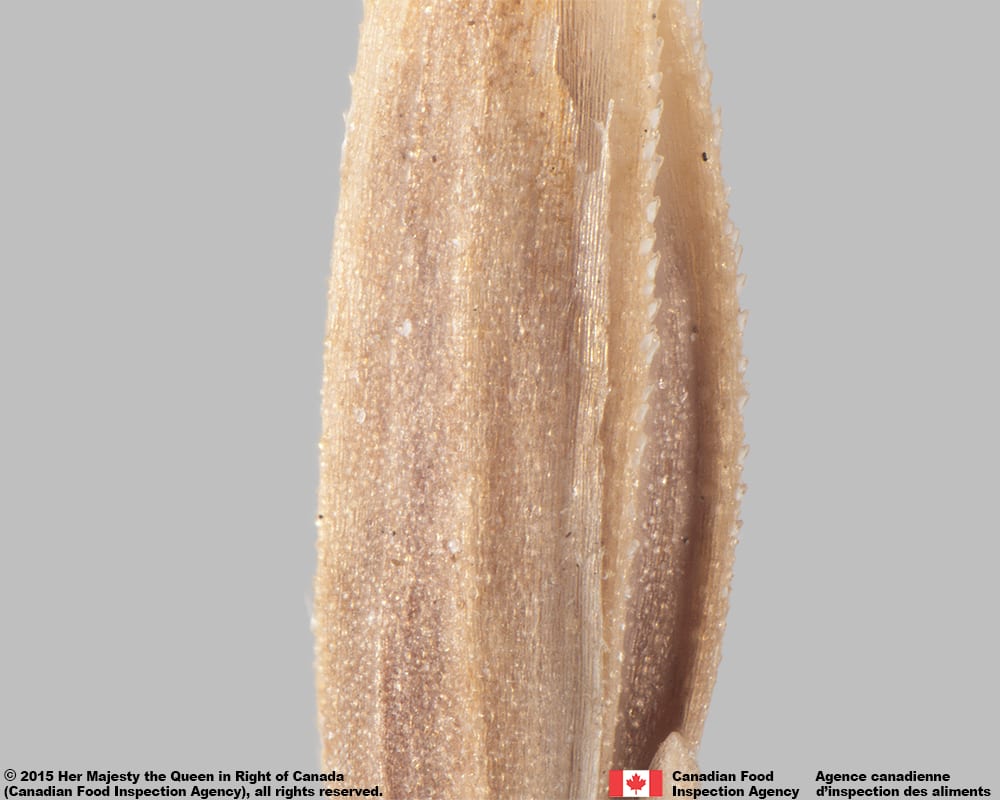
Poa pratensis
Poaceae
Kentucky bluegrass (Poa pratensis) floret, side view
Need ID Help?
Besoin d’aide pour l’identification?
Reference(s)
Référence(s)
Alderson, J. and W. C. Sharp. 1995. Grass varieties in the United States, U.S.D.A. Agric. Handbook 170, rev. ed. CRC Press.
Association of Official Seed Analysts (AOSA). 2022. Rules for Testing Seeds, Vol. 1: Principles and Procedures. Association of Official Seed Analysts, Washington D. C.
Barkworth, M. E., Capels, K. M., Long, S., and Piep, M. B. (eds.). 2007. Flora of North America Volume 24. Magnoliophyta: Commelinidae (in part): Poaceae, part 1. Oxford University Press, New York, New York.
Bojňanský, V. and Fargašová, A. 2007. Atlas of Seeds and Fruits of Central and East-European Flora: The Carpathian Mountains Region. Springer, Dordrecht, The Netherlands.
Brown, E. and Hillman, F. H. 1905. The seeds of the bluegrasses. U. S. Dept. of Agriculture, Bureau of Plant Industry, Bulletin No. 84. Government Printing Office, Washington D.C.
Canadian Food Inspection Agency (CFIA). 2023. Canadian Methods and Procedures for Testing Seeds (M&P). Version 1.1, English. Canadian Food Inspection Agency.
Center for Agriculture and Bioscience International (CABI). 2023. Poa compressa (Canada bluegrass) – Datasheet. CABI – Invasive Species Compendium. https://www.cabidigitallibrary.org/doi/full/10.1079/cabicompendium.42487. Accessed January 3, 2023.
Douglas, G. W., Meidinger, D., and Pojar, J. (eds.). 2001. Illustrated Flora of British Columbia Vol. 7 Monocotyledons (Orchidaceae through Zosteraceae). British Columbia Ministry of Sustainable Resource Management and Ministry of Forests. p. 250. https://www.for.gov.bc.ca/hfd/pubs/docs/Mr/Mr106.pdf.
Edgar, E. and Conner, H. E. 2000. Flora of New Zealand, Volume V Gramineae. Manaaki Whenua Press. Lincoln, Canterbury, New Zealand.
eFloras. 2023. Flora of China. Poa pratensis. efloras.org Accessed January 3, 2023.
Government of Canada (GC). 2016. Canadian Weed Seeds Order. https://laws-lois.justice.gc.ca/eng/regulations/SOR-2016-93/page-2.html (English); https://laws-lois.justice.gc.ca/fra/reglements/DORS-2016-93/page-2.html (French) Accessed January 5, 2023.
International Seed Morphology Association (ISMA). 2020. Method for seed size measurement. Version 1.0. ISMA Publication Guide. https://www.idseed.org/authors/details/method_for_seed_size_measurement.html.
Martin, A. C. 1946. The comparative internal morphology of seeds. The American Midland Naturalist 36(3):513-660.
Musil, A. F. 1963. Identification of Crop and Weed Seeds. Agriculture Handbook No. 219. U. S. Department of Agriculture. Washington, D.C.
Sharp, D. & Simon, B.K. 2002. AusGrass: Grasses of Australia. CD-ROM, Version 1.0 (Australian Biological Resources Study, Canberra, and Environmental Protection Agency, Queensland). https://keys.lucidcentral.org/keys/v3/AusGrass/key/AusGrass/Media/Html/POA/POACOM.HTML Accessed January 3, 2023.
St. John, L., Tilley, D., and Winslow, S. 2012. Plant guide for Canada bluegrass (Poa compressa) USDA-Natural Resources Conservation Service, Plant Materials Center, Aberdeen, Idaho 83210. https://plants.sc.egov.usda.gov/DocumentLibrary/plantguide/pdf/pg_poco.pdf.
Terrell, E. E. 1971. Survey of occurrences of liquid or soft endosperm in grass genera. Bull. Torr. Botan. Club 98(5):264-268.
United States Department of Agriculture-Agricultural Marketing Service (USDA-AMS). 2023a. Federal Seed Act Regulations. https://www.ecfr.gov/current/title-7/subtitle-B/chapter-I/subchapter-K/part-201 Accessed January 3, 2023.
United States Department of Agriculture-Agricultural Marketing Service (USDA-AMS). 2023b. State Noxious-Weed Seed Requirements Recognized in the Administration of the Federal Seed Act. https://www.ams.usda.gov/sites/default/files/media/StateNoxiousWeedsSeedList.pdf Accessed January 4, 2023.
United States Department of Agriculture-Agricultural Research Service-National Plant Germplasm System (USDA-ARS). 2023. Germplasm Resources Information Network (GRIN Taxonomy). National Germplasm Resources Laboratory, Beltsville, Maryland. https://npgsweb.ars-grin.gov/gringlobal/taxon/taxonomydetail?id=28934 Accessed January 3, 2023.
Germplasm Resources Laboratory, Beltsville, Maryland. URL: https://npgsweb.ars-grin.gov/gringlobal/taxon/taxonomydetail?id=28934 Accessed January 3, 2023.
Wiersema, J. H. and León, B. 1999. World Economic Plants: A Standard Reference. CRC Press, Boca Raton, FL.
Wright, W. H. 1940. The “seeds” of the genus Poa commonly found on the market. Contribution to the Handbook on Seed Testing. Association of Official Seed Analysts.



